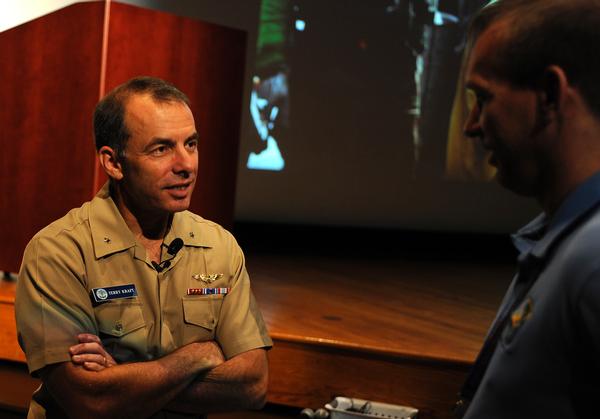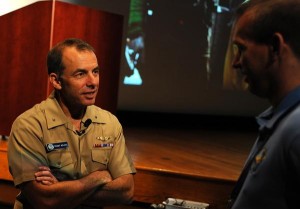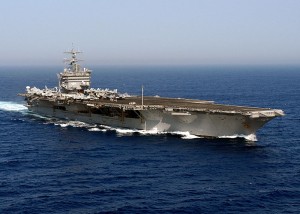Big E Fights Pirates


Rear Adm. Terry Kraft, commander, Carrier Strike Group (CSG) 12, left, debriefed NAVAIR's Patuxent River workforce Oct. 12. (US Navy photo)
USS Enterprise (CVN 65) has a history of firsts. As the world’s first nuclear-powered aircraft carrier, Enterprise is also the first aircraft carrier used to pursue pirates, Rear Adm. Terry Kraft, commander, Carrier Strike Group (CSG) 12, told the NAVAIR workforce Oct. 12.
Kraft recounted the CSG’s recent six-month deployment to about 250 NAVAIR employees at the fifth Meet the Fleet post-deployment debrief, which serves as part of NAVAIR Commander Vice Adm. David Architzel’s initiative to strengthen the command’s connection to the warfighter.
Operating in the Mediterranean and the Arabian seas within the Navy’s 5th Fleet area of responsibility, Enterprise CSG supported the war in Afghanistan and Operation New Dawn in Iraq. The deployment included missile strikes in Libya, counter-piracy events and several counter-terrorism missions.
“The CSG’s deployment was so busy that there was no time for planned non-combatant operations,” Kraft said. The intelligence picture drove the schedule, he said. “It was changing what we were doing and planning for every single day.”
That changing schedule proved to be a challenge because logistics support in the Red Sea is not an easy thing to do, Kraft said.
“When it comes to an aircraft carrier, it is all about CODs [Carrier Onboard Delivery aircraft],” he said. “I call it the ‘House of CODs.’ You rely on that 30-year-old [C-2A Greyhound] aircraft to keep you going. That was challenging, but we got through it.”
A new COD aircraft used for cargo and logistics transport to carrier strike groups was at the top of Kraft’s wish list, he said in answer to an audience question.
Counter-piracy kept the CSG very busy, he said.
“One of the big challenges the Navy faces is piracy,” Kraft said. “It’s throughout the theater; it’s prevalent; it’s going to be wherever our Navy ships are operating in 5th Fleet.”
During its recent deployment, the Enterprise CSG was involved in nine counter-piracy events including the capture of the Somali pirates who killed four American hostages after boarding the sailing vessel Quest in February, Kraft said.
“Almost 60 pirates were either captured, killed or turned back over to Somalia while we were out there,” he said. “Countless ships were freed to continue their passage.”
Kraft shared two strategies that work to counter piracy. “One, if you have a private, armed security force onboard, they will be able to repel the pirates,” he said. The other thing that thwarted pirate hijackings was the crew’s use of a citadel, or secure room where the crew can hide, Kraft said.
“On three different occasions, as a ship was being pirated, the crew secured themselves inside their citadel and we were still able to talk to the Master,” he said.
“With the crew safe in the citadel, pirates lose their most important asset, which is being able to get hostages,” he said. “Once we know the crew is in the citadel, it allows us more freedom of action to go after these guys to get them to surrender.”
The best strategy, though, is to go after the pirate’s infrastructure on the beach, Kraft said. “They are just going to keep coming from Somalia.”
Following his debrief, Kraft answered several audience questions including what capabilities he would like to see on the F/A-18 Super Hornet.
He replied that he would to like to see several existing systems on the Hornet continue to be funded. “The SHARP, or Shared Reconnaissance Pod, enabled us to run hundreds and hundreds of targets and download the images to the ship or aircraft,” he said.
RAIDER, or Rapid Attack Information Dissemination Execution Relay, provided the ability to take snapshots off the Hornet’s forward-looking infrared and send images back to the carrier, he said.
“Those are great capabilities, and I know there have been questions whether we are going to continue to fund them,” he said.
After using the joint helmet-mounted cueing system (JHMCS) for the first time, Kraft said it was a great situational awareness tool, particularly operating over Afghanistan. The JHMCS is a multi-role system that enhances pilot situational awareness and provides head-out control of aircraft targeting systems and sensors.
In a follow-on interview, Kraft said, “I had a great interaction at Pax River today. It’s always fun to talk to the people who design and build the systems. I think it gives them a good end-to-end look at how the things they design work operationally. And it’s a chance for me to say how much I appreciate that.”
Enterprise, the oldest carrier in the fleet, turns 50 this November and will launch its 22nd and final overseas deployment next year before being decommissioned in the fall of 2012.
Source: NAVAIR Headquarters























